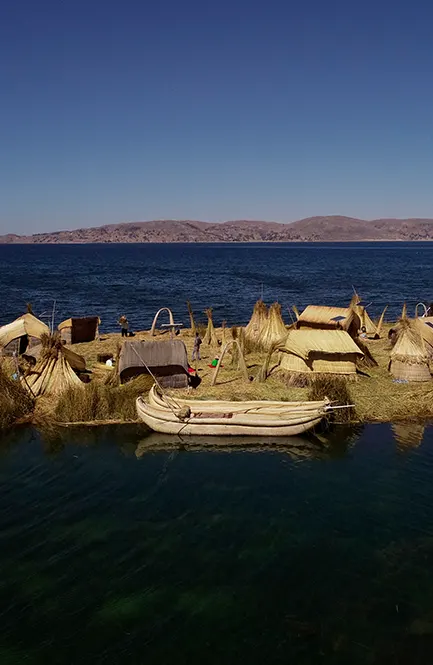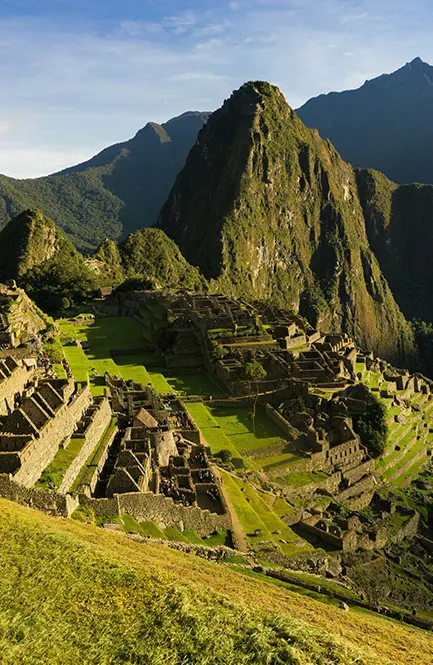Flying through the South American skies, in the steep and deep reliefs of the Andes Mountains, it is possible to see the elegant flight of one of the largest birds in the world: the Andean Condor. A bird considered an Andean divinity since ancient times.
Join Auri to discover the secrets of one of the most majestic birds on the planet, the undisputed king of the Andes Mountains and a symbol of millenary culture and biodiversity, the Andean Condor.
Scientific name and order of the Andean Condor
The scientific name of the Andean Condor is Vultur Gryphus. This animal belongs to the Cathartidae family and although its order is still in dispute, due to the different theories regarding its lineage, it is known that it has no subspecies.
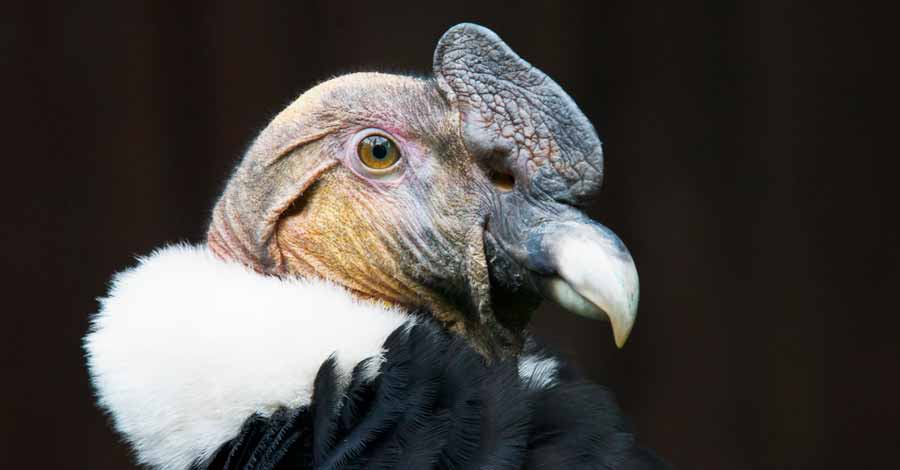
Etymology of the word “Condor”
Its name comes from the Quechua word “Kuntur” which is currently translated as Condor. However, it can also be translated as “The largest of all birds”.
Andean condor description
Andean condor is the largest non-marine flying bird in the world. It is only surpassed on the coasts by the Wandering Albatross, a bird that with its wings outstretched measures 3.5 meters from one wing to the other. Although there are reports of condors that reach the same length.
Like their relatives, the Californian condor and the jungle condor, Andean condors sport bald heads like all scavenger birds. Their heads have a blackish color with pink and orange tones, it changes color depending on the mood and season. The exposed skin is reddish-brown in color, and this skin forms folds that become more accentuated and grow as the years go by.
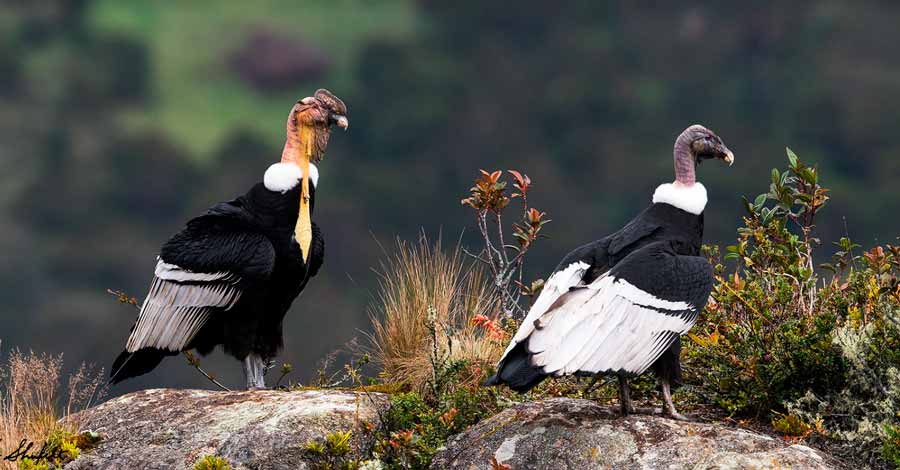
Female and male reach sexual maturity at 10 to 12 years of age and breed every two to three years. The male has a fleshy crest called the caruncle. Adolescent condors are often confused with mountain eagles because they do not have the white collar characteristic of the species, but this distinctive feature is only achieved at 8 years of age by both females and males. Their body is black with white wing coverts. Its beak is white and legs are gray, with large toes.
Both Andean condor genres have a short hooked beak specialized for tearing; the featherless neck as a result of evolution allows them to put their head into the body of dead animals without getting dirty, small and bald head; their eyelidless eyes have an angle 2 times wider than that of humans. The strong legs are similar to the legs of a hen, they are not prehensile and have short nails.
Andean condor wingspan
The Andean condor, during its adulthood, has an average size of 1.30 meters, from the base of the tail to the beak. With its wings spread out, it reaches 3.3 meters; the weight varies from 12 kg (females) to 15 kg (males), it is undoubtedly the most impressive bird of the American continent.
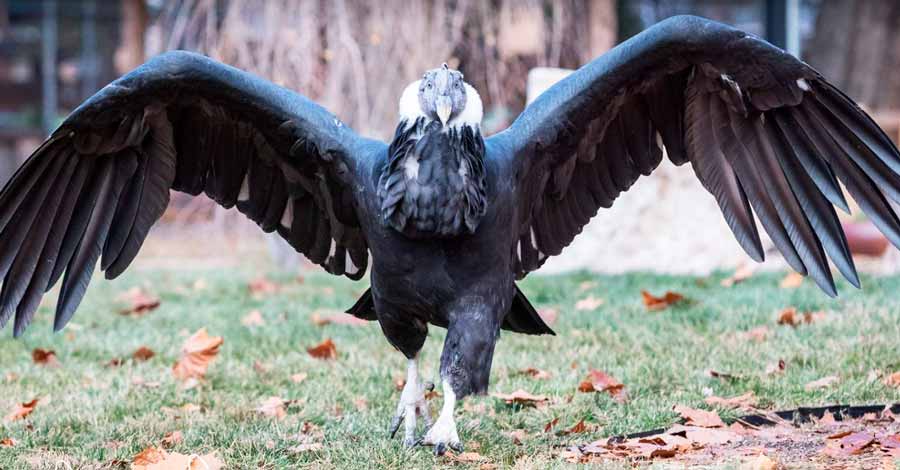
Andean condor lifespan
Condors are very long-lived animals. They are capable of living up to 80 years in captivity and about 50 years in the wild.
Behavior and reproduction of the Andean Condor
The Andean Condor is a solitary bird, it can be seen in pairs or large groups when feeding, or nesting between 1000 and 5000 meters above sea level, forming colonies in natural cavities, in steep rocky walls, which are preferred to establish the nest, the primary requirement for the site chosen is to be able to take off and land without difficulty.
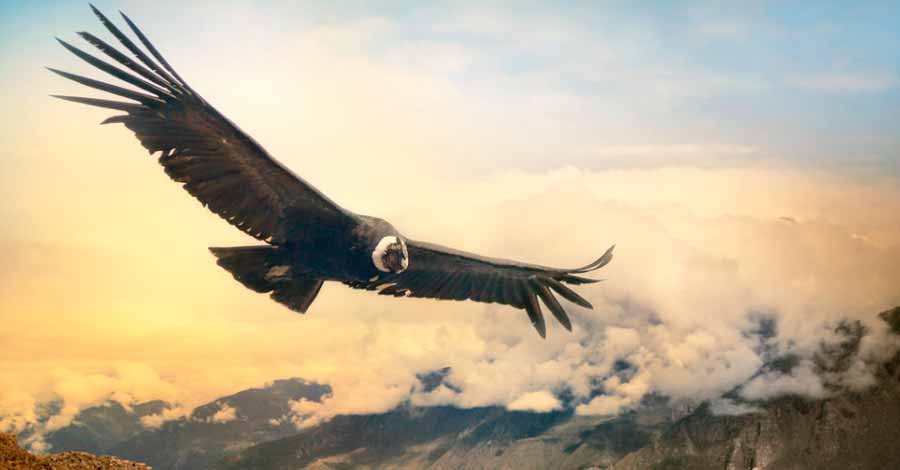
The female lays a single egg, which is incubated by both parents, for a period of approximately two months and then they take turns caring for the chick, looking for food to raise it until it is approximately 5 months old. The nests are generally located in caves or sheltered ledges in vertical walls, in many cases inaccessible to predators by land.
In the Apurímac region of Peru, there is an important population of Andean condors, probably due to the large number of horses raised in the area, which, when they die, provide food for this population.
The hunter bird of the air currents.
The condors take advantage of the presence of the hot air currents that are created in canyons to leave their nests and thus rise in perfect glide above the rocky walls.
Condors begin to leave in search of targets in the form of carrion to feed on. Their large size and weight make this scavenger bird an impressive threat. Their technique of using air currents to their advantage by gliding from high above allows them to exploit their extraordinary vision, which they use to lock on to their target and drop at breakneck speeds.
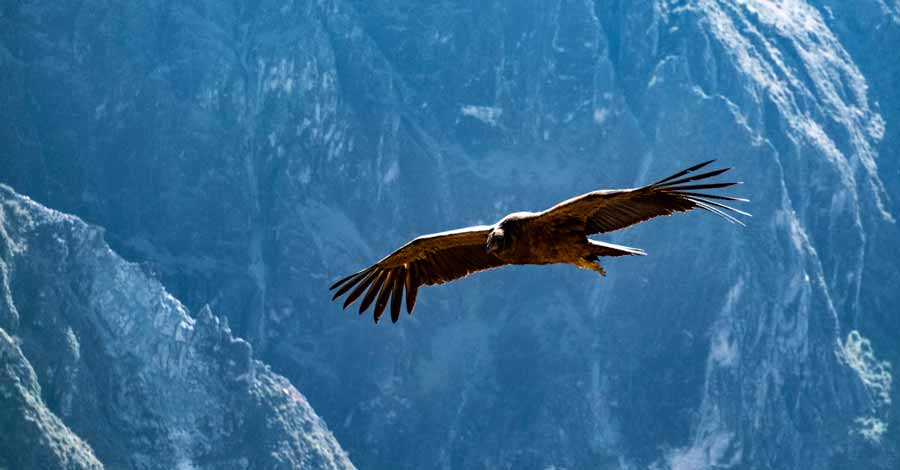
Origin and evolution of the Andean Condor
As we already mentioned, the Andean condor belongs to the Cathartidae family of birds of the Cathartiformes order, from which the Teratornithidae family is also derived, a now extinct family from which the current condors descend. The Terathornithidae group has its origin in the European Tertiary, they were a group of carnivorous carrion-eating birds with little flight capacity and large body size. These birds began the colonization of the New World through North America, and then gradually descended towards the south of the continent during the early Miocene.
The wider distribution of condors began at the beginning of the Quaternary period. All condor families were centered mainly on the coastal strips and the extensive plains of the pampas, and no evidence of condors was found in the steep Andes Mountains, their current area of distribution.
It is remarkable the Argentavis magnificens, with a wingspan of 6 to 8 meters, which inhabited the Argentine pampas some 6 to 8 million years ago, being the largest flying bird that has ever existed.
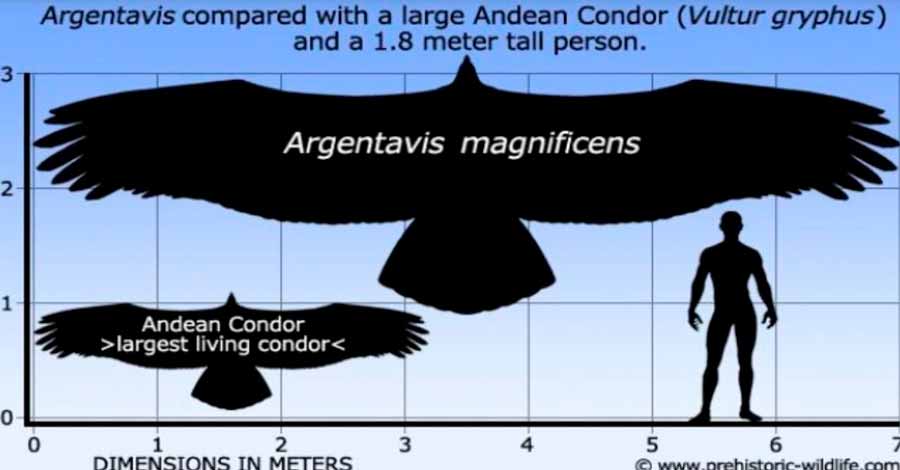
After the extension of the fauna of large mammals in the transition to the Pleistocene (1.75 million years ago) as a consequence of climatic changes, the Andean condor came to occupy the highest rank that had been vacant among the scavengers.
The Andean condor has a long evolutionary history in South America. The fossil of the oldest condor in South America belongs to a condor called “Kuntur Cardenasi”, a 14 to 10 million year old condor discovered in Peru.
Distribution of the Andean Condor in South America
At present it is possible to see the condor in all its splendor in all the territories covered by the Andes mountain range, mountain ranges close to it or to the coasts adjacent to the Pacific Ocean and the Atlantic Ocean, from the south of Tierra del Fuego (Chile and Argentina) to the west of Venezuela. Two of its major habitats are in southern Peru, in the Colca Canyon in the province of Caylloma, Arequipa, and the next in the Mayobamba Canyon in the Peruvian region of Ayacucho. It can also be seen in the Apurimac Canyon near the town of Chonta in the district of Limatambo in the Inca region of Cusco.
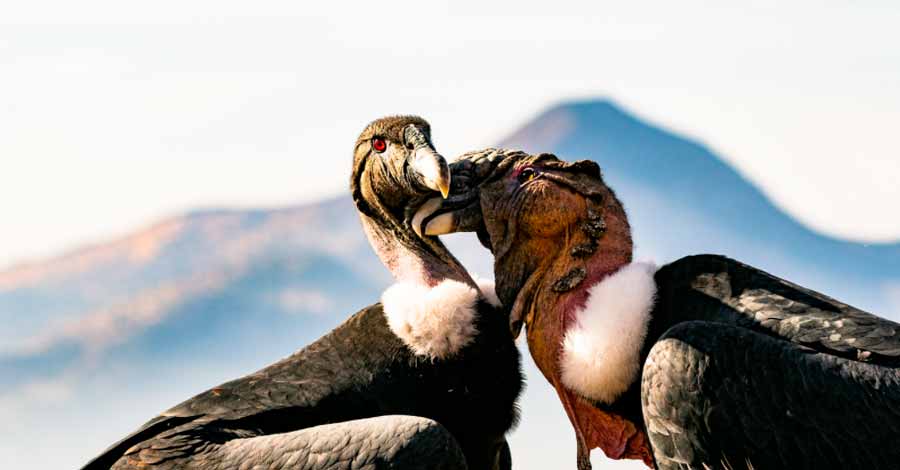
In Ecuador they can be found in: Antisana Eco Reserve, Cotacachi-Cayapas Eco Reserve, Zuleta in the province of Imbabura, Cotopaxi National Park and El Cajas National Park. Its distribution in Argentina has reached the Atlantic Ocean in the provinces of Tierra del Fuego, Santa Cruz, Chubut and Río Negro. The Andean regions of northern Argentina have relatively large and apparently stable populations.
Social importance of the Andean Condor in South America
The Andean condor is a national symbol in Argentina, Bolivia, Chile, Colombia, Ecuador and Peru, playing an important role in the folklore and mythology of the South American Andes. It has been declared the national bird of Colombia, an emblematic bird in Argentina and in Chile it has been granted the title of natural monument.
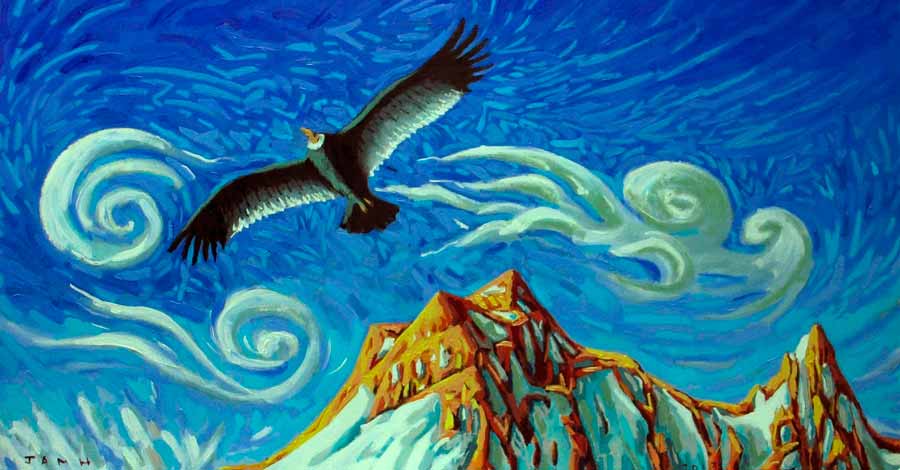
Why is the andean condor the national bird of Ecuador, Chile, Colombia and Bolivia?
The image of the Andean condor is represented in different South American coats of arms due to its historical, social and environmental importance in South American societies.
Today the image of the Andean condor is found on four national coats of arms, where it represents different values: in Bolivia (the search for a limitless horizon), in Chile (strength), in Colombia (freedom and order), and in Ecuador (power, greatness and courage).
History of the Andean Condor in Peru
The condor is historically considered a sacred bird; it has witnessed the origin and splendor of several pre-Columbian cultures and civilizations, acquiring a symbolic role in many of them. It has even been represented in ceramics, paintings and textiles. Its presence was highly valued as a mythological and religious symbol.
The Incas were among his greatest admirers: they came to consider him a divinity in charge of uniting heaven and earth, a “Messenger of the Gods”, the union between the Hanan Pacha (earthly world) and the Kay Pacha (celestial world). For a long time it has been part of the Andean cosmovision of man; representing a living divinity as it was part of the Andean trilogy together with the puma and the serpent.
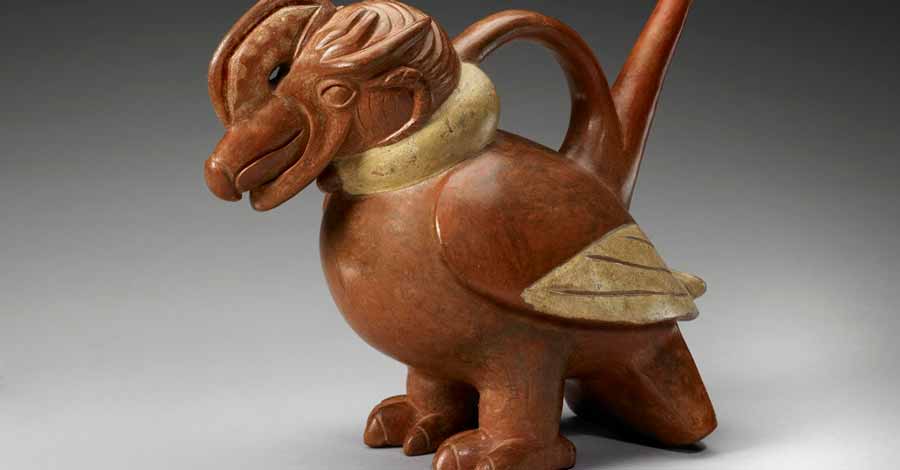
This mystical relationship is also demonstrated in one of the main temples of the Machu Picchu sanctuary, the temple of the Condor, where the figure of the condor lies in detail engraved on a large stone. Historians assure that it is possible that this effigy was used as a sacrificial altar, since it is thought that there was a belief that condors were capable of raising the spirits of the dead to heaven.
The impression it caused in the Spaniards was so great that the Andean condor was registered in the first coat of arms that the city of Cusco had. For Spanish conquerors, the image of the condor was synonymous with a being of great respect for the Andean culture. But at the same time, its religious connotation of “sacred image” was the main reason to justify its persecution and extermination by Catholic fanatics who considered it an evil and harmful bird.
After the independence of the South American colonies, the condor regained great historical and social importance. Today it is one of the most sacred, respected and valuable birds in all the countries of the Andes Mountains.
The friendship between the Condor and the Andean fox
It is said that the Andean condor and the Andean fox are animals that are generally associated by carrion. In the Colca Valley in Peru it is said that they have an alliance, as they have great respect for each other. When a condor discovers a dead animal, it stays circling until its friend the fox arrives, who bites the prey and checks that there is no trap. Once the Andean fox has finished its work and consumed its share, the condor is finally encouraged to come down.
Ecological role of the Andean Condor
The Andean condor plays an important ecological role as a scavenger because it accelerates the process of decomposition of dead animals, thus reducing the risk of diseases associated with the slow putrefaction of animals.
Why is the andean condor endangered?
Currently, the Andean condor is classified as Near Threatened (NT) by the red list of the International Union for Conservation of Nature.
The main causes of the reduction of the population of this species are illegal hunting and capture for the use of specimens in traditional festivals such as the Yawar Fiesta (traditional festival that was banned in Peru), the commercialization of their feathers or parts, intoxication and poisoning to which they are subjected by the false belief that they hunt cattle, as well as the decrease in the quality of the habitat due to global warming.
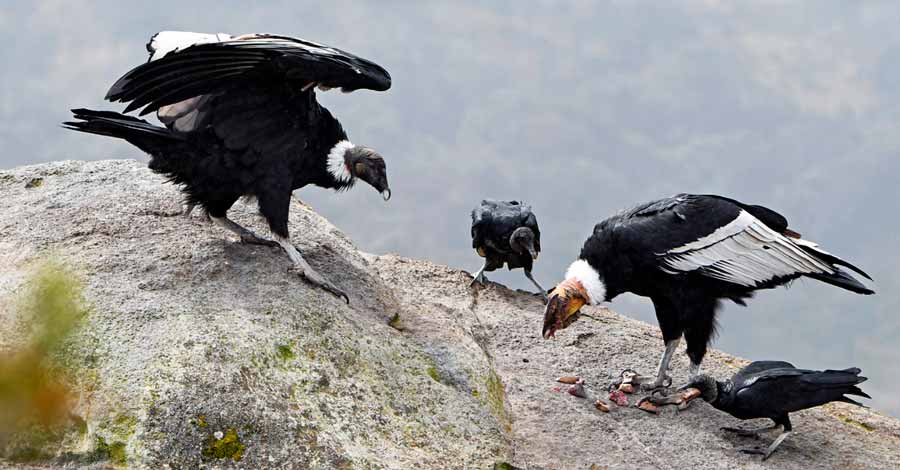
Where to see Andean Condor in Peru?
Colca canyon in Arequipa
The perfect place to witness the flight of the Andean Condor in Peru is undoubtedly the Colca Canyon in the southern region of Arequipa. The Andean Condor is the main attraction of the Colca, like all kings, the condor is elusive and not so easily seen; but suddenly, as if out of nowhere, it can pass almost brushing past its spectators. At other times it can only be seen in the distance, as a dot above the mountains.
You can find the visit to the Colca Canyon in the following tour packages, however in Auri Peru we are ready to customize your trip to include the majestic flight of the Condor.
Chonta Canyon (Apurimac Canyon) in Cusco
Another perfect place to watch the flight of the Andean Condor is in the canyon of the Apurimac, in the area of a town called Chonta in Cusco, this place is also called the canyon of Chonta or the canyon of the Condor. Although the place is not yet well known or promoted, we can find strategic viewpoints in the area from where you can see large numbers of condors in the early hours of the morning and at sunset.
Curiosities about the Andean Condor:
- At certain times of the year (in October in Peru), condors fly from the peaks of the Andes to the Pacific coast to eat the carrion of dead sea lions.
- It is one of the only predators that can break the tough skin of South American camelids (llamas, alpacas, huanacos and vicuñas) with its beak.
- The Andean condor is part of the Cathartidae family, which comes from the Greek kathartes meaning “the one who cleans”.
- The Andean condor does not emit any sound and is practically mute due to the involution of its vocal cords or syrinx.
- The Andean Condor produces a nuptial courtship to attract its mate. Condors step back and forth with their wings open and at the same time cluck and hiss.
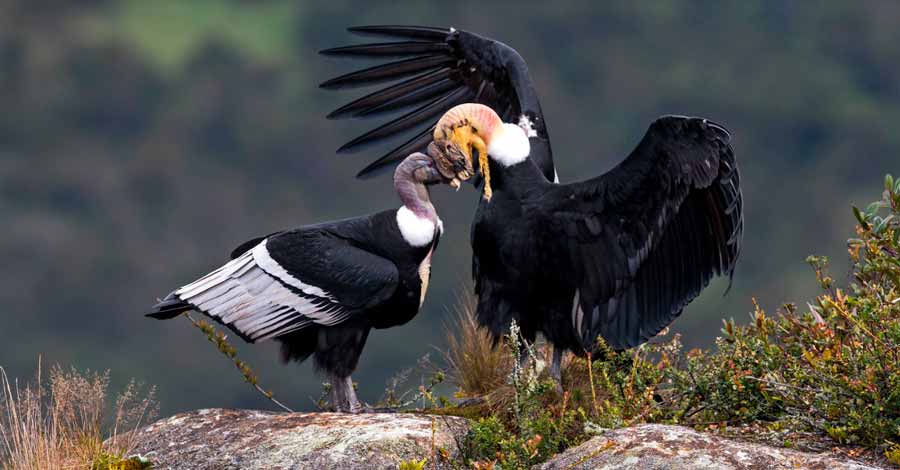
- They move long distances with their mastery of the air, in an elegant flight, with techniques to control the winds without flapping for long periods of time and with minimum energy consumption.
- They can travel above 6000 or 7000 meters (3700 to 4700 ft bove sea level) and patrol the firmament; only he can live with the scarce oxygen contained in the atmosphere above the Cordillera traveling 200 km / 124 miles in a day between the nesting sites in the mountains and the search for food.
- There is a myth, although it is not proven, that says that the Andean condor, when it feels old or when it loses its lifelong partner, swoops down until it meets its death on the rocks.
Master and lord of the Andean skies, the Andean condor amazes everyone who has the privilege of observing its majestic flight. Contact Auri Peru to live such an incredible experience as witnessing the flight of one of the most majestic birds on the planet, a fascinating spectacle that conveys an absolute sense of beauty and freedom.





